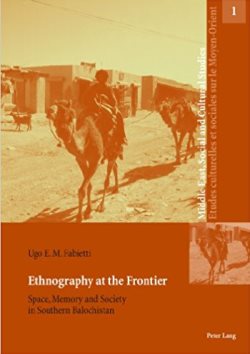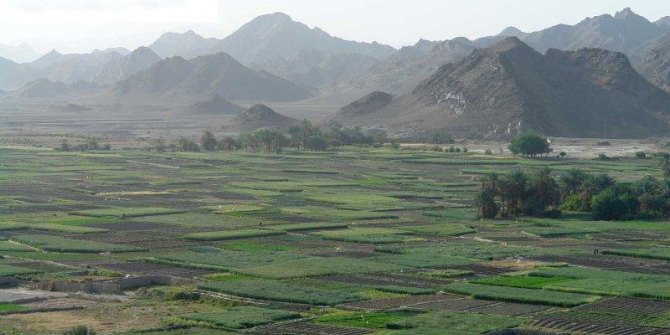In this rare anthropological study based on extensive fieldwork in Balochistan, Ugo Fabietti explores the question of social change in this ‘peripheral’ region of Pakistan which is negotiating with both new forces and reformulations of its past. Hammal finds the book an ambitious and path breaking work which seeks to understand the region on its own terms.
Ethnography at the Frontier: Space, Memory and Society in Southern Balochistan. Ugo Fabietti. Peter Lang AG Internationaler Verlag Der Wissenschaften. 2011.
 There is a dearth of serious socio-scientific literature on Balochistan. The region is remote, isolated; expansive, and has a small population. The rare works that are published usually set up the developments in the context of wider geopolitical issues: the Cold War, regional rivalry, proxy wars, and occasionally federal design. Needless to say, this approach is popular with distant observers and armchair experts. However, in Ethnography at the Frontier: Space, Memory and Society in Southern Balochistan, Ugo Fabietti seeks to understand the southern Balochistan or Makkuran (the local name for the region) on its own terms.
There is a dearth of serious socio-scientific literature on Balochistan. The region is remote, isolated; expansive, and has a small population. The rare works that are published usually set up the developments in the context of wider geopolitical issues: the Cold War, regional rivalry, proxy wars, and occasionally federal design. Needless to say, this approach is popular with distant observers and armchair experts. However, in Ethnography at the Frontier: Space, Memory and Society in Southern Balochistan, Ugo Fabietti seeks to understand the southern Balochistan or Makkuran (the local name for the region) on its own terms.
The study is the result of eight years (1986 – 1994) of fieldwork, and is set in a village. It is not common for foreign researchers to spend this long in the region (the notable exception is Robert Pehrson, who studied the social organisation of the Marri Tribe in early 1960s), and given the current security situation in Balochistan, it is unlikely there anyone will be writing a follow up in the near future as it is almost impossible to conduct impartial research. Fabietti, Professor of Anthropology at the University of Milan, is interested in the broader question of social change in ‘peripheral’ regions; in southern Balochistan he finds a region which largely exists outside the imperatives of capitalism and globalisation. Yet, at the same time the area has been caught in the ‘winds of change’ brought by these forces. The author finds the confluence of the ‘tribal’ and the modern instructing; in the same vein, he imagines this junction to be a frontier, one that is in constant flux and engaged in the process of negotiation with the new forces and reformulations of its past.
This picture is obviously very different from what one sees in a standard account of Balochistan: that of a society trapped in a time warp and perpetual conflict. This image is produced and reproduced by both insiders and outsiders for varied and, more often than not, for self-serving reasons. On the contrary, this study places Balochistan, in the contemporary and breaks away from placing ‘remote’ areas in a certain schema – a trend once quite dominant in anthropology as a discipline as well. However, the placement of the area in the contemporary does not comes with a discount of the history. Rather, the now of the Southern Balochistan is situated as a continuum of the past, both of area itself and the places and peoples with which it interacted. This approach makes the past less fossilised. Moreover, the author’s reformulations do not come with the rejection of local accounts. In fact, he uses them to construct his models to make sense of the continuity and change in the local society. That possibly is one of the methodological charms of anthropology.
The key contribution of the book arguably lies in the considerations given to the agricultural geography of the area. The Karaiz system – a series of horizontal wells which enables water to flow from an elevated source to low lying irrigable lands – for centuries served as the backbone of the productive property. As the locus of the local economy, the system shapes the social relations of the area. Fabiattei not only enables his readers to comprehend the intricate regime of the water rights in the area, but also recounts the ways in which it orders the social form of the locale. The detribalisation of the Makkuran, an often cited but not much investigated subject, is placed here as a function of water rights, land ownership and inheritance customs.

Forms of individualisation and flexibility are presented through water rights, which create a participatory space in an otherwise rigid and stratified social order organised around Zaats (social groups), the membership of which defines the social position of an individual. This contradiction in the Southern Balochistan’s society is best captured in the chapter ‘Equality and Hierarchy’. Moreover, the author challenges, the popular notion that the Zaats were lineage based, instead he understands them to be patronymic groups. Essentially, this line of argument calls into question the theoretical models presented in the past, which imagined the social order as ossified and with no room for social mobility. Alternatively, Fabiaetti shows, that it at the intersection of these opposing forces, of hierarchy and of equality, that shapes Makkuran’s society.
It was indeed a time of great changes one learns. The monetization of the economy, the breakdown of patron-client relations and the general collapse of the social order were already underway when Fabiaetti was conducting his fieldwork. However, two phenomenon particularly affected Makkurani society: the emergence of drug lords, and the massive migration of labour to the gulf countries. The drug lords, with their newfound wealth and coercive power, challenged the established social order. It was in the late 80s and early 90s that a new class of ‘Big Men’ emerged. The labour migration created a serious shortfall of the workers, which hit the agricultural sector – the traditional source of the economic gain and social prestige – particularly hard. With the collapse of the local economy, the politically affluent started to tilt towards the new encroaching power: the state. This is demonstrated by the fact that from the mid-1990’s onwards the ‘contentious politics’, to use Charles Tilly’s categorisation, had largely subsided (although it made a violent comeback the following decade with new set of actors).
The exclusionary politics that seemingly dominates southern Balochistan’s landscape today is not corroborated by the history of the region, one learns from the book. Located at the crossroads of South Asia and the Middle East, the area has received its fair share of foreign influence throughout the ages. Fabietti argues the assertions of the homogeneity in the local populace emerged as a response to the extralocal forces. Against a backdrop of powers that sought to superimpose change and ‘development’, the Balochi nationalist movement gained popular support in the area. The book does talk about the growing tensions between the central government and the region. However, one learns that the intensity of the conflict was much lower than what we witness today. Moreover, Fabietti reflects on how the Balochi nationalist movement manages construct to coherent imagination of the past, future and political ambition despite obvious inconsistencies. He credits nationalist intellectuals with playing the leading role in this discourse construction. Thus, his understanding of the Balochi movement is essentially political – as opposed to ethnic.
Ethngraphy at the Frontier, despite its small size, is an ambitious book. It observes, dissects and explains the southern Balochistan’s society in a holistic manner. One feels that one hundred and thirty pages are not enough, given the breadth of the project and the book leaves the reader craving more. The book does not give out any information on the dynamics of the gender in the area and if they were changing at all. A particularly important subject during the times of social change is thereby, ignored. More space should have been dedicated to the growing tensions between the Sunnis and Zikris, two sects of the Islam that are practiced in the region. The issue is fleetingly touched upon in the book and that too in the context of the nationalist movement. Despite these shortcomings, this is a path breaking work, as it records great changes in southern Balochistan and in the process, opens up new questions for the future investigators. The minimal use of disciplinary jargon makes the book an easy read. The style of the author is lively, with which he brings otherwise placid subjects, such as the geography of the area, into life. It is indeed a pleasant surprise that this style was not lost in the translation, as the book has been translated from Italian into English.
This article gives the views of the authors, and not the position of the South Asia @ LSE blog, nor of the London School of Economics. Please read our comments policy before posting.
About the Author
Hammal teaches International Relations at a public university in Quetta, Balochistan. He holds a Masters in International Relations from Quaid e Azam University, Islamabad and an MSc in Comparative Politics from LSE.








It is an old book yet it is good enough to know the epitome of the culture of the mentioned area.
Moreover, if globalization means internet connection that such places are present in the most developed nation where there is no connectivity.